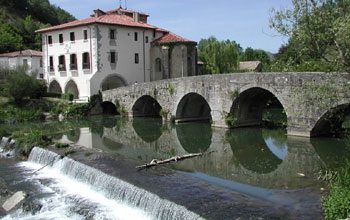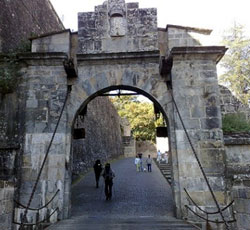Camino de Santiago - French Way - Stage 3
Larrasoaña to Pamplona (also known as Iruña in Basque)
Total distance: 15.9 kilometres
Leave Larrasoaña the same way you entered, via the Puente Larrasoaña and passing the map of the Camino the path takes an uphill track heading towards the village of Aquerreta 1 kilometre away where there is a single hotel. From here the path takes you through the village and through some pine woods and down a steep descent and some steps until you reach a modern bridge across the Rio Arga and after 3 kilometres, the village of Zuriáin.
About 400 metres down the main road you will be re-crossing the Rio Arga through another pine forest heading towards the village of Irotz, a walk of 2 kilometres, where you will find a fountain to fill up your water bottles. From Irotz you again cross the river via a medieval bridge and follow the path through the village of Uroz and towards the village of Zabaldica where you will find a statue of St James in the Iglesia de San Esteban. The church is usually locked but the key is available from one of the nearby houses.
Once again on the path and heading uphill once more you will arrive at the small village of Arleta. Here there is a nice manor house and the Iglesia de Santa Marina. The area around Arleta is particularly beautiful in spring and summer when the path is lined with orchids.

The path continues for approximately 1km until you reach the tunnel underneath the main road. Taking this route you will reach a medieval bridge over the Rio Ulzama and the hamlet of Trinidad de Arre. Here you will find the Albergue situated behind the Basilica de la Sanctisima Trinidad de Arre, which is the white building as you cross the bridge, as well as a number of bakeries and other places to eat.
At the Basilica de la Sanctisima Trinidad de Arre there is an old monastery and the remains of a pilgrim hospice.
Not far along the main road from Trinidad de Arre you will come across the village of Villava, birthplace of Miguel Ángel Indurain Larraya who won the Tour de France on 5 consecutive occasions between 1991 and 1995. Villava is also a suburb of the first major city on the Camino Frances, the city of Pamplona.

After 1.5 kilometres the route takes you through the suburb of Burlada and past a house known as la Casa de las Conchas due to it being decorated in scallop shells.
You will once again have to cross the Rio Arga using the medieval bridge Puente de la Magdalena which is decorated with stone statues and a cross which was donated by the city of Santiago de Compostela in the 1960's. Just after this bridge is an Albergue to your left.

The path then takes you through the public gardens called Playa Caparroso towards the city walls surrounding the medieval part of the city of Pamplona. Here you walk over a draw bridge through the Portal de Zumalacárregi also known as el Portal de Francia and into the old town of Pamplona. Pamplona was originally a Basque village called Iruña until 74BC when the Roman General Pompeyo Magno founded the new Roman town of Pompaelo, naming it after himself obviously. Over the centuries the city was populated by Visigoths and the Moors.
During the 12th century at the height of the Camino there was an influx of people, particular French (or Franks) and they settled within the city and the city was segregated into 3 burgos or boroughs built around a parish church. Two of them, San Cernin and San Nicolás were Frankish and the other Navarreria, was where the Basques settled. Internal walls divided each of the boroughs mainly because of many disagreements between the different peoples. In 1423 King Carlos III el Noble (the noble) pulled down the walls and banned the building of any walls within the city, basically making the settlers integrate.
The city walls and the Citadel were built between the 16th and 18th centuries because of the city's strategic importance being so close to the French border and also to repel any possible invasion. In the 19th century as the city grew some of the walls, at the south side, were demolished to allow expansion of the city.
Pamplona is most famous for the Fiesta de San Fermin when they run the bulls through the streets. The Fiesta was made world famous by Ernest Hemingway who first attended the Fiesta in 1923 and made it the backdrop of his novel “The Sun Also Rises”. He returned a further 8 times with his last visit in 1959. The city council paid tribute to Hemingway by unveiling a monument next to the bullring on the Paseo Hemingway, the street that had been named in his honour. The Fiesta takes place in early July so be aware when making plans to travel that accommodation may be a little hard to come by at this time.
There are a number of places in Pamplona worthy of a visit including the walls and some of the lovely squares and parks.
Continued on Stage 3 - page 2

